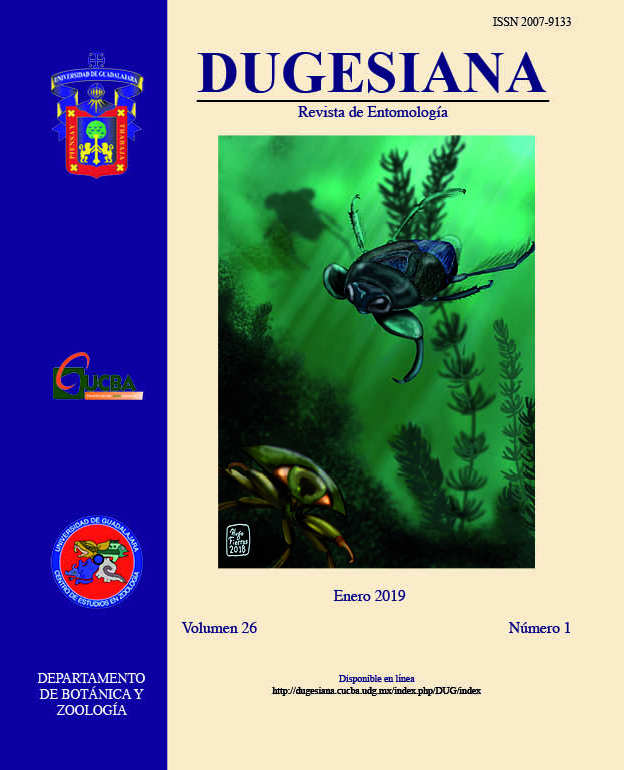Nuevos registros de hormigas (Hymenoptera: Formicidae) en la Isla María Cleofas, Golfo de California, México
DOI:
https://doi.org/10.32870/dugesiana.v26i1.7067Keywords:
Islas Marías, lista de especies, mirmecofauna, NayaritAbstract
La mirmecofauna de la Isla María Cleofas, una de las cuatro áreas insulares de la Reserva de la Biosfera del archipiélago de las Islas Marías en el Golfo de California, México, es poco conocida. En este trabajo se registran por primera vez para la isla a Camponotus atriceps, C. rectangularis, Leptogenys ixta, Pseudomyrmex elongatus y Solenopsis geminata. Asimismo, la documentación fotográfica previa de Atta mexicana en la localidad, fue confirmada por la revisión de especímenes.References
AntWeb. 2018a. Species: Monomorium cyaneum Wheeler, 1914. AntWeb v7.34.4. https://www.antweb.org/description.do?genus=monomorium&species=cyaneum&rank=species. Fecha de consulta: 28 de agosto de 2018.
AntWeb. 2018b. Species: Neivamyrmex nigrescens (Cresson, 1872). AntWeb v7.34.4. https://www.antweb.org/description.do?rank=species&genus=neivamyrmex&name=nigrescens. Fecha de consulta: 3 de septiembre de 2018.
AntWiki. 2015. Atta mexicana. http://www.antwiki.org/wiki/Atta_mexicana. Fecha de consulta: 25 de agosto de 2018.
AntWiki. 2017. Camponotus planatus. http://www.antwiki.org/wiki/Camponotus_planatus. Fecha de consulta: 28 de agosto de 2018
Boulton, A.M. and P.S. Ward. 2002. The biological scene: Ants. (pp. 112-128). In: Case, T.J., M.L. Cody and X. Ezcurra (Eds.). A new island biogeography of the Sea of Cortés. Oxford University Press, Oxford.
CONABIO. 2007. Programa de conservación y manejo Reserva de la Biosfera Islas Marías, México. SEMARNAT-CONANP, México.
DuBois, M.B. 1986. A revisión of the native new world species of the ant genus Monomorium (minimum group) (Hymenoptera: Formicidae). The University of Kansas Science Bulletin, 53(2): 65-119.
Gonçalves, C.R. 1942. Contribuição para o conhecimento do gênero Atta Fabr., das formigas saúvas. Boletim da Sociedade Brasileira de Agronomia, 5(3):333-358.
Gregg, R.E. 1969. New species of Pheidole from Pacific coast islands (Hymenoptera: Formicidae). Entomological News, 80: 93-101.
Lattke, J.E. 2011. Revision of the New World species of the genus Leptogenys Roger (Insecta: Hymenoptera: Formicidae: Ponerinae). Arthropod Systematics & Phylogeny, 69(3): 127-264.
Mackay, W.P. y E.E. Mackay. 1989. Clave de los géneros de hormigas en México (Hymenoptera: Formicidae). (pp. 1-82) In: Memoria del II Simposio Nacional de Insectos Sociales. Sociedad Mexicana de Entomología, Oaxtepec, México.
Mackay, W. y E. Mackay. 2004. Especies de Camponotus de México. https://www.utep.edu/leb/ants/Mexicacamp.doc. Fecha de consulta: 28 de agosto de 2018.
Naturalista-CONABIO. 2018a. Hormiga chicatana negra (Atta mexicana). https://www.naturalista.mx/observations/3183812. Fecha de consulta: 4 de septiembre de 2018.
Naturalista-CONABIO. 2018b. Camponotus planatus. https://www.naturalista.mx/observations/3300675. Fecha de consulta: fecha de consulta 24 de agosto de 2018.
Pacheco, J.A. and W.P. Mackay. 2013. The systematics and biology of the New World thief ants of the genus Solenopsis (Hymenoptera: Formicidae). The Edwin Mellen Press, Lewiston.
Trager, J.C. 1991. A revision of the fire ants, Solenopsis geminata group (Hymenoptera: Formicidae: Myrmicinae). Journal of the New York Entomological Society,99(2):141-198.
Vásquez-Bolaños, M. 2011. Lista de especies de hormigas (Hymenoptera: Formicidae) para México. Dugesiana, 18(1): 95-133.
Watkins, J.F.II. 1982. The army ants of Mexico (Hymenoptera: Formicidae: Ecitoninae). Journal of the Kansas Entomological Society, 55(2): 197-247.
Ward, P.S. 1989. Systematic studies on pseudomyrmecine ants: revision of the Pseudomyrmex oculatus and P. subtilissimus species groups, with taxonomic comments on other species. Quaestiones Entomologicae, 25(4): 393-468.
Wilson, E.O. 2003. Pheidole in the New World. Harvard University Press, Cambridge.
Additional Files
Published
Issue
Section
License
1. Proposed policy for open access journals
Those authors who have publications with this journal, accept the following terms:
- The authors will retain their copyright and will guarantee to the journal the right of first publication of their work, which will be simultaneously subject to the Creative Commons Recognition License, which allows third parties to share the work whenever their author is indicated and His first publication is this journal.
- Authors may adopt other non-exclusive license agreements to distribute the version of the published work (eg to be deposited in an institutional telematic file or published in a monographic volume) provided the initial publication is indicated in this journal .
Authors are encouraged and encouraged to disseminate their work through the Internet (eg in institutional telematic files or on their web page) before and during the sending process, which can produce interesting exchanges and increase appointments Of the published work. (See The effect of open access).
2. Proposed policy for journals that offer open deferred access
Those authors who have publications with this journal, accept the following terms:
- The authors will retain their copyrights and will guarantee to the journal the right of first publication of their work [SPECIFY PERIOD OF TIME], which will be simultaneously subject to the Creative Commons Recognition License that allows third parties to share the work always That its author and his first publication be indicated this journal.
- Authors may adopt other non-exclusive license agreements to distribute the version of the published work (eg to be deposited in an institutional telematic file or published in a monographic volume) provided the initial publication is indicated in this journal .
- Authors are encouraged and encouraged to disseminate their work through the Internet (eg in institutional telematic files or on their web page) before and during the sending process, which can produce interesting exchanges and increase appointments Of the published work. (See The effect of open access).




